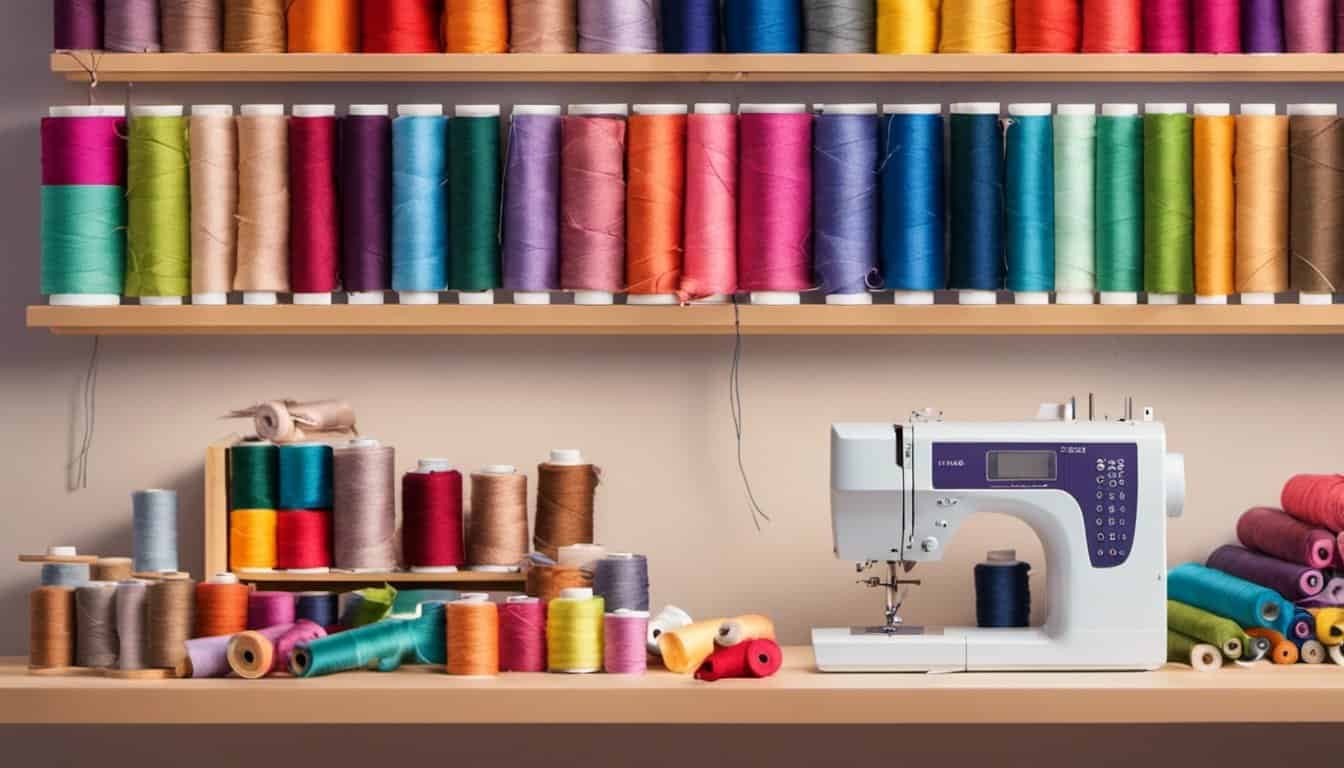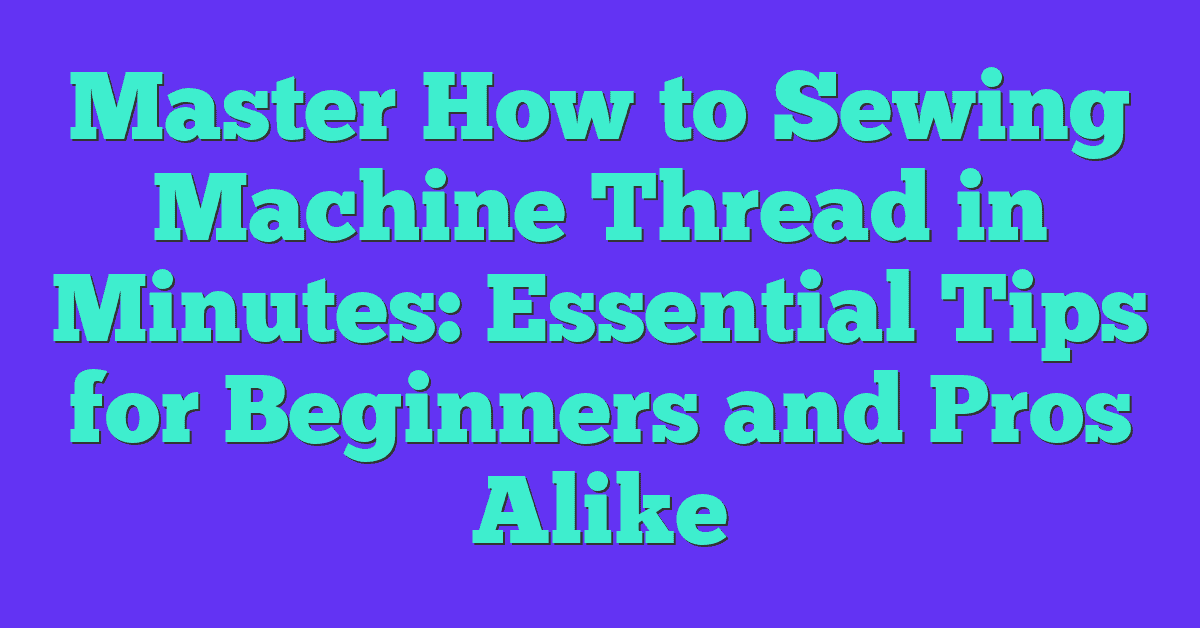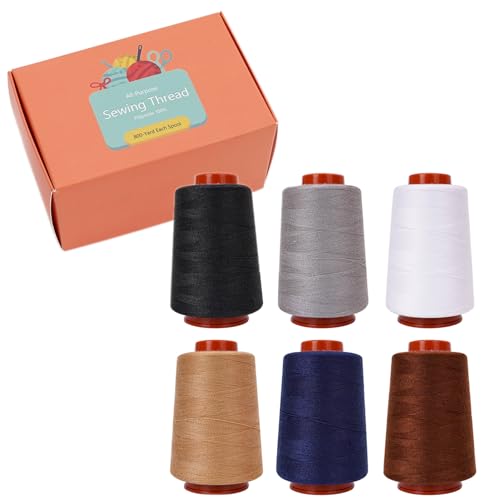Got a new sewing machine but feeling a bit lost on how to thread it? You’re not alone! Many beginners find threading their machine to be a daunting task, but it doesn’t have to be. With a little guidance, you’ll be ready to start stitching in no time.
Understanding the Basics of Sewing Machine Threading
Threading your sewing machine can initially feel daunting, but understanding the fundamentals simplifies the process. Ensuring proper threading is critical for smooth and efficient sewing.
Types of Sewing Machines
Knowing your sewing machine type influences how you thread it. There are three main types:
- Mechanical Sewing Machines: These rely on manual adjustments. You’ll turn dials for tension and stitch selection.
- Electronic Sewing Machines: These offer automated features. You’ll press buttons to set stitching patterns.
- Computerized Sewing Machines: These integrate digital interfaces. You’ll use a screen to input settings.
Understanding your model is critical before threading. Refer to the machine’s manual for specific guidance.
Importance of Proper Threading
Accurate threading ensures your sewing machine functions correctly. Incorrect threading can lead to various issues:
- Thread Breakage: Misthreading stresses the thread, causing breakage.
- Skipped Stitches: Improper threading disrupts needle and bobbin coordination, leading to skipped stitches.
- Tension Problems: Incorrect threading can affect thread tension, resulting in uneven or loose stitches.
Proper threading minimizes issues and enhances your sewing experience, ensuring smooth operation and quality results.
Preparing to Thread Your Sewing Machine
To ensure smooth threading, it’s essential to prepare your sewing machine correctly. This foundation will save you time, prevent issues, and enhance your sewing experience.
Gathering the Necessary Supplies
You’ll need several items to thread your sewing machine properly. Gather the following:
- Thread: Select a high-quality thread suitable for your fabric.
- Bobbin: Ensure you have an empty bobbin compatible with your machine.
- Scissors: Small, sharp scissors will trim thread ends neatly.
- Sewing Needle: Check that the needle is the correct size and type for your fabric.
- Machine Manual: If available, refer to the manual for specific instructions.
Setting Up Your Sewing Machine
Position your machine on a stable, well-lit surface. Follow these steps:
- Turn Off the Power: Unplug the machine to avoid accidental starts.
- Raise the Needle: Use the handwheel to lift the needle to its highest position.
- Lift the Presser Foot: This action frees the tension discs, making threading easier.
- Wind the Bobbin: Place the empty bobbin on the bobbin winder, thread it, and engage the winder. Follow your machine’s instructions for winding.
- Insert the Bobbin: Place the wound bobbin into the bobbin case or directly into the machine, depending on the type.
With these steps completed, you’re ready to thread your sewing machine. This preparation helps ensure a smooth and efficient sewing process, preventing common issues like thread breakage and tension problems.
Step-by-Step Guide to Threading a Sewing Machine
Properly threading your sewing machine is essential for smooth and efficient sewing. Follow these steps to thread your machine correctly, ensuring it operates without issues.
Winding the Bobbin
First, complete the winding process for the bobbin. Place the spool of thread on the spool pin, ensuring it’s secured with a spool cap. Guide the thread through the thread guide and tension disc, then wrap it around the bobbin several times. Place the bobbin onto the bobbin winder spindle and push it to the right. Start the machine to wind the thread onto the bobbin evenly, then cut the thread and remove the bobbin once it’s fully wound.
Threading the Top Thread
Raise the presser foot and turn the handwheel to lift the needle to its highest position. Place the thread spool on the spool pin and secure it with the spool cap. Pull the thread through the first thread guide, then follow the threading path down through the tension area, catching the take-up lever. Ensure the thread moves smoothly through the path and check your machine’s manual if you encounter any obstacles. Finally, thread the needle from front to back, making sure the thread flows freely and without tangles.
Threading the Bobbin
Access the bobbin case by opening the bobbin cover or sliding plate. Place the wound bobbin into the bobbin case, ensuring the thread winds in the correct direction as specified by your machine’s manual. Pull the thread through the slit and under the tension spring, leaving a 4-6 inch tail. Replace the bobbin cover and draw the bobbin thread up through the needle plate using the needle thread, turning the handwheel if necessary. Ensure both threads are positioned under the presser foot and toward the back of the machine.

By following these steps, you’ll properly thread your sewing machine, paving the way for a successful sewing session.
Troubleshooting Common Threading Issues
Even with careful threading, problems can occasionally arise. Identifying and solving these issues ensures smooth sewing.
Tension Problems
Incorrect tension settings often lead to uneven stitches. Adjusting the tension dial based on fabric type and thread thickness typically resolves the issue. For instance, thicker fabrics may need a higher tension setting. Consult your machine manual for specific settings.
Use the same type of thread in both the bobbin and the top spool. Mismatched threads can cause tension irregularities. Also, ensure the needle is appropriate for the fabric; using a denim needle for delicate fabrics can strain the thread, leading to tension problems.
Thread Breaking or Bunching
Thread breaking or bunching usually indicates improper threading or tension. Double-check the threading path. Make sure the thread passes smoothly through the tension discs, take-up lever, and needle eye. Thread correctly ensures consistent stitch formation.
« Unlock the Secrets of Sewing Interfacing: How to Transform Your DIY Projects
Uncover the Secrets: How to Use a Singer Sewing Machine Like a Pro (Beginners Guide Included) »
Clean the machine frequently. Lint and dust can clog the tension discs and threading path, causing thread to break. Periodic cleaning with a small brush or compressed air keeps these areas clear.
Check the needle condition. A bent or dull needle can cause thread to fray and break. Replacing needles every 8-10 hours of sewing keeps them in optimal condition.
If issues persist, consulting the service manual or seeking professional help might be necessary. Proper maintenance and threading practices prevent common problems, enhancing your sewing experience.
Maintenance and Care of Your Sewing Machine
Proper maintenance of your sewing machine ensures smooth operation and long life. Regular cleaning and professional servicing play significant roles in this upkeep.
Regular Cleaning
Cleaning your sewing machine regularly removes lint, dust, and fibers that accumulate during sewing. Start by turning off and unplugging the machine. Remove the needle, presser foot, and bobbin case. Use a small brush, often provided with the machine, to remove debris from the feed dogs, bobbin area, and around the needle plate. Avoid using canned air, as it can push debris deeper into the machine. Check the manual for recommended oiling points and apply sewing machine oil sparingly. Perform this cleaning after every few projects or as specified in the manual.

Periodic Professional Servicing
Professional servicing keeps your sewing machine in peak condition. Schedule a service with a certified technician every 12 to 18 months or after extensive use. During servicing, technicians will inspect, clean, and lubricate internal components and check for any worn parts. This proactive care prevents major issues and extends the machine’s lifespan. If you notice any persistent problems like unusual noises or skipped stitches, consult a professional earlier.
Maintaining a consistent cleaning routine and seeking professional help periodically ensures your sewing machine’s longevity and optimal performance.
Conclusion
Threading your sewing machine might seem daunting at first but with a bit of practice and patience you’ll get the hang of it. Remember to always check your machine type and follow the specific threading instructions to avoid any hiccups. Regular maintenance is your best friend when it comes to keeping your machine in top shape so don’t skip those cleaning sessions and professional check-ups. With these tips in mind you’ll be well on your way to smooth and enjoyable sewing sessions. Happy sewing!

















